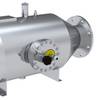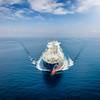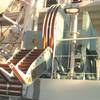In Safety, Quality Comes First
Benchmarked, standardized and customizable – Rapp Marine’s array of crane options safely cover the full gamut of workboat needs.
In the marine industry, one of the most potentially dangerous pieces of deck equipment on a vessel is the crane. The trigger of a serious failure can range from a simple operator error to significant mechanical overload. Consequences can be devastating in human terms, certainly expensive from lost revenue and costs to repair, to say nothing of cleaning up the mess. These are compelling incentives for the prospective crane customer to look for a crane both engineered and manufactured to the highest industry and quality standards. In today’s global marketplace, it is difficult to distinguish the quality differences behind the computer illustration, one crane tends to look like another. There needs to be another way for buyers to ensure receiving a high-quality, safe crane.
Benchmarking to a High Standard
You can’t put a price on safety. With that in mind, the crane division of Rapp Marine U.S. (formerly Rapp-Hydra Pro) puts quality at the top of the priority list. Rapp employs the American Petroleum Institute to hold it accountable to high quality standards. Going beyond ISO 9001:2008 quality standards, Rapp also adheres to be a strict Quality Management System in order to maintain an API Q1 Specification.
There are several key differences between ISO 9001 and API Spec Q1, but the additional requirements contained within API Spec Q1 mandate the formal documentation of risk assessment and management. The Q1 specification makes sure that certified manufacturers such as Rapp are formally documenting all of the checks and balances of the design and manufacturing process, to ensure that all of quality standards are being met. These checks and balances include documenting employee competency, ensuring that vendors of critical parts meet quality standards, and heading off potential issues through robust preventative maintenance.
Cranes built by Rapp Marine may be certified to API spec 2C, a unique certification known as “monogramming” that may be applied by crane manufacturers that meet these rigorous quality standards. The API 2C certification provides the end user with an easy way of knowing that the crane that they are purchasing has met the set of requirements that are outlined by API, and that API has made sure that the manufacturer has gone through intensive audits to maintain the certification.
Since initially implementing the quality system over 6 years ago, Rapp Marine has realized a payoff for both themselves and the end user. Creation of cranes meeting such high quality standards has resulted in units that provide reliable service for an extended lifetime. Beyond this, internal warranty related costs have almost disappeared. And a further benefit of the quality program implementation is that should an issue occur with a particular crane, the documentation allows review of similar cranes that are currently in use which potentially may suffer a similar problem. Proactive repair and maintenance of any identified issue can result in big savings in both costs as well as the safety for the crew and the vessel.
Standardized Features Customized
In addition, Rapp Marine has leveraged its QMS processes to better capture the specific requirements of each customer. With long standing customers in the fishing, offshore, and LNG markets, Rapp Marine is often depended upon to provide affordable, robust solutions to meet its customers’ requirements. One example is a new crane design developed for Foss Maritime, which is building a new Fireboat 20 and its sister ship for the Port of Long Beach. The crane features a personnel basket that is self-leveling via a master-slave cylinder system. The basket can also be manually tilted and slewed, its underside is outfitted with LED flood lights and a camera.
In order to fit the crane into the tight space allotted on the vessel, but also be capable of achieving the required reach, Rapp engineers came up with a double-telescopic boom. The crane can be controlled via wireless remote, basket controls, or from the platform. A telescopic ladder is mounted to the booms of the crane.
Rapp Marine features standard model cranes including fixed boom, telescopic, knuckle, double-telescopic, and knuckle extension type cranes from two to 100 tons in capacity. Typically, the standard crane models are customized according to each customer’s specific application. Crane projects with lift capacities up to 100 tons are fabricated in-house in the Seattle, WA, production facility in order to protect the quality of the product. The fabrication of any crane with lift capacity above 100 tons is outsourced to a qualified manufacturer in the U.S. or Europe. “We like to have control over the production of critical components wherever possible,” Ben Jordan, Rapp Marine Senior Engineer, told MarineNews in January. “We find it is easier to control processes and ensure quality when the product is made under our roof so that is what we do whenever possible.” Rapp Marine cranes also feature hardened stainless steel rods as standard on luffing cylinders, which are fabricated in house by certified welders.
By catering to the distinct application of each customer, Rapp Marine continues to collect custom options that can be quickly applied to the next project. These options include an assortment of platform and cab options, custom retractable ladders, wireless controls systems, load limiting systems, boom mounted service platforms, roto-seals, roto-joints, LMI systems, personnel baskets and custom hydraulic solutions. In addition, Rapp Marine produces custom winches and hoists built to meet the requirements of all the major classification societies.
Rapp Marine builds custom hydraulic power units for explosion-proof atmospheres including IECEX, ATEX and Class 1 Div. 1. Power units can be built in special configurations or integrated into the pedestal of the cranes.
One-Stop Shopping
Under a company structure set in place by new CEO Helge Vatnehol, all of the various manufacturing and product centers of the Rapp Marine group around the globe have been combined into one entity, Rapp Marine. This allows for an extensive suite of deck machinery to be offered for research, fishing, offshore oil and workboat vessels. The combination of engineering capacity in Rapp Marine’s Bodø, Norway, and Seattle, USA locations has opened up new opportunities that are now within the company’s capabilities.
A great example of synergy created by this new company structure is the design of a 150 ton knuckle crane that will be provided to an offshore oil vessel in the Gulf of Mexico. The crane has been designed in Norway by engineer Helge Stakkeland, using proven techniques and technologies to reduce weight and increasing performance. The crane meets the requirements of DNV Lifting Appliances and is capable of lifting 150 tons at 17 meters. Outfitted for subsea operations including active heave compensation and a winch capable of storing 3,100 meters of 77mm wire rope, this will be the first of many cranes that will be able to meet the heavy load demands of offshore vessels in the Gulf of Mexico and around the world.
(As published in the February 2015 edition of Marine News - http://magazines.marinelink.com/Magazines/MaritimeNews)














